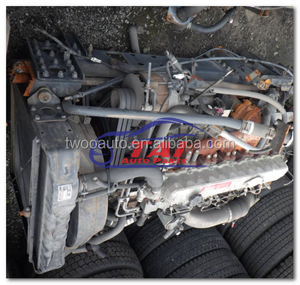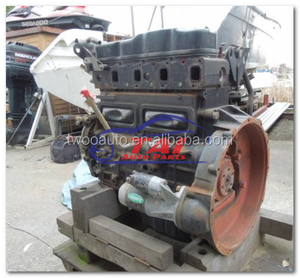(132 products available)






























































































































































The Hino HO7C engine is a commercial-grade diesel engine built for heavy-duty tasks. It is mainly used in trucks and buses. While the engine is a reliable workhorse, it has various types that differ in specifications and features. Here are the different types of the Hino HO7C engine:
Regular Oil Changes:
Regular oil changes are important for the Hino HO7C engine. New oil should be added every 5000 miles to keep the engine running smoothly. The fresh oil protects the engine parts by reducing friction.
Coolant Level Checks:
The coolant level in the reservoir should be checked before each trip. Topping up is important to avoid overheating of the Hino engine. The coolant circulates to absorb heat and keep the engine from getting too hot.
Air Filter Replacement:
The air filter should be checked every 10000 miles. Dust buildup in the filter blocks airflow, which reduces engine power. A new air filter allows more air to reach the engine cylinders. This improves combustion, fuel efficiency, and power output.
Tire Rotation:
It is important to have the tires rotated every 8000 miles. The tires wear evenly with rotation. Even tires provide better traction, handling, and stability for the vehicle. The tire longevity is also improved by rotating the tires.
Brake Pad Inspection:
The brake pads should be inspected for wear every 15000 miles. Thinning pads reduce braking performance and safety. New pads should be installed before they become too thin. This prevents damage to the brake rotors.
Fuel Filter Change:
The fuel filter should be replaced every 20000 miles. Over time, dirt and debris buildup in the filter blocks fuel flow. A new fuel filter ensures that gasoline flows smoothly to the engine. This prevents fuel starvation and maintains engine performance.
Chassis Lubrication:
It is important to grease the suspension and chassis every 30000 miles. The moving parts work better with lubrication. Greasing prevents squeaking and reduces wear on components like joints and linkages.
Timing Belt Inspection:
The timing belt should be examined for cracks or damage at 60000 miles. A worn belt can snap, causing serious engine problems. A skilled mechanic should check the timing belt tension and condition.
Electrics and Lighting:
The vehicle's electrical system and lights should be tested every 40000 miles. Low battery voltage or faulty bulbs can cause starting issues or dim lighting.
Understand the Business Needs:
The first thing to consider is understanding the business needs. What kind of business operations are done? Is it logistics, construction, or any other field? Knowing the business type will help decide on the engine power needed for the operations.
Consider the Vehicle Type:
Different vehicles use different engine types. One needs to consider the type of Hino engine available in the vehicle. Check out the cab-over engines (COE) and conventional engines (non-COE). Know the vehicle type one uses to choose the right engine for it.
Check the Emission Standards:
Before buying an engine, one needs to check out the emission regulations in their area. Different regions have set emission standards that need to be followed. Know the emission standards and choose an engine that meets those regulations.
Evaluate Fuel Efficiency:
In business operations, one needs to move goods or products from one place to another. This involves a lot of driving. Therefore, choosing an engine that is fuel efficient and saves gas money is very important. The Hino HO7C engine is known for its good fuel efficiency. One can save a lot on fuel costs by using it in their vehicle.
Consider Maintenance and Serviceability:
When choosing an engine, consider how easy it is to maintain and repair. Check out the availability of spare parts and the required maintenance schedule. Choose an engine that is easy to service and maintain to keep it running smoothly with minimal downtime.
Assess Power and Performance Requirements:
Different business operations have different power and performance needs. For instance, if one does heavy hauling, they will require an engine with higher torque and pulling power. But for light deliveries, a standard engine will be enough. Assess the power and performance needs before selecting an engine.
Consider the Initial Cost and Total Cost of Ownership:
When choosing an engine, consider the purchase price and the total cost of ownership. The total cost of ownership includes fuel costs, maintenance costs, insurance, and resale value. Evaluate everything to make a more informed decision.
It is not recommended to replace an Hino 4-cylinder engine as it requires specialized knowledge. However, below are the general steps that should be taken to replace a Hino HO7C engine.
Q1: How do I know if the Hino HO7C engine is the right choice for my vehicle?
A1: The Hino HO7C engine is a heavy-duty diesel engine designed for commercial vehicles. If your vehicle is a light-duty passenger car, this engine may be too powerful and not fuel-efficient enough for your needs. Consider the size and type of your vehicle, as well as its intended use (e.g., city driving, highway cruising, towing, etc.). If you require a robust engine for a larger vehicle with demanding performance requirements, the Hino HO7C may be suitable.
Q2: Can the Hino HO7C engine be used for off-road applications?
A2: While the Hino HO7C engine is primarily designed for on-road use in commercial vehicles, it can also be used in some off-road applications that require a high-torque, low-speed engine. However, additional modifications may be needed to adapt the engine for severe conditions, such as dust, dirt, moisture, and extreme temperatures. Consult with Hino or an authorized dealer for advice on using the HO7C engine in off-road vehicles.
Q3: What is the warranty period for the Hino HO7C engine?
A3: The warranty period for the Hino HO7C engine varies depending on the country, state, province, or region's regulations and the dealer's terms. Generally, the warranty covers defects in materials and workmanship under normal use and maintenance. It also usually excludes damage from accidents, misuse, neglect, modifications, or unauthorized repairs. For specific warranty information, contact the local Hino representative or check the warranty booklet that comes with the vehicle.
Q4: What is the expected lifespan of the Hino HO7C engine?
A4: The expected lifespan of the Hino HO7C engine depends on several factors, such as the level of care and maintenance it receives, its operating environment and conditions, the load it carries, and its driving habits. Generally, with proper maintenance and care, a Hino diesel engine can last for 400,000 to 500,000 kilometers (approximately 250,000 to 310,000 miles) or more. However, the engine's performance may gradually decline over time, affecting fuel efficiency, emissions, and power output.
Q5: What are some common problems with the Hino HO7C engine and how to fix them?
A5: Like any other engine, the Hino HO7C may have some issues at some point. Some possible signs include noise, vibration, smoke, warning lights, low power, etc. These problems may be caused by various factors, such as mechanical failure, electrical issue, fuel system problem, exhaust system blockage, etc. To troubleshoot and fix these problems, users are advised to refer to the user manual for guidance or contact a qualified mechanic or Hino's authorized dealer for professional diagnosis and repair.